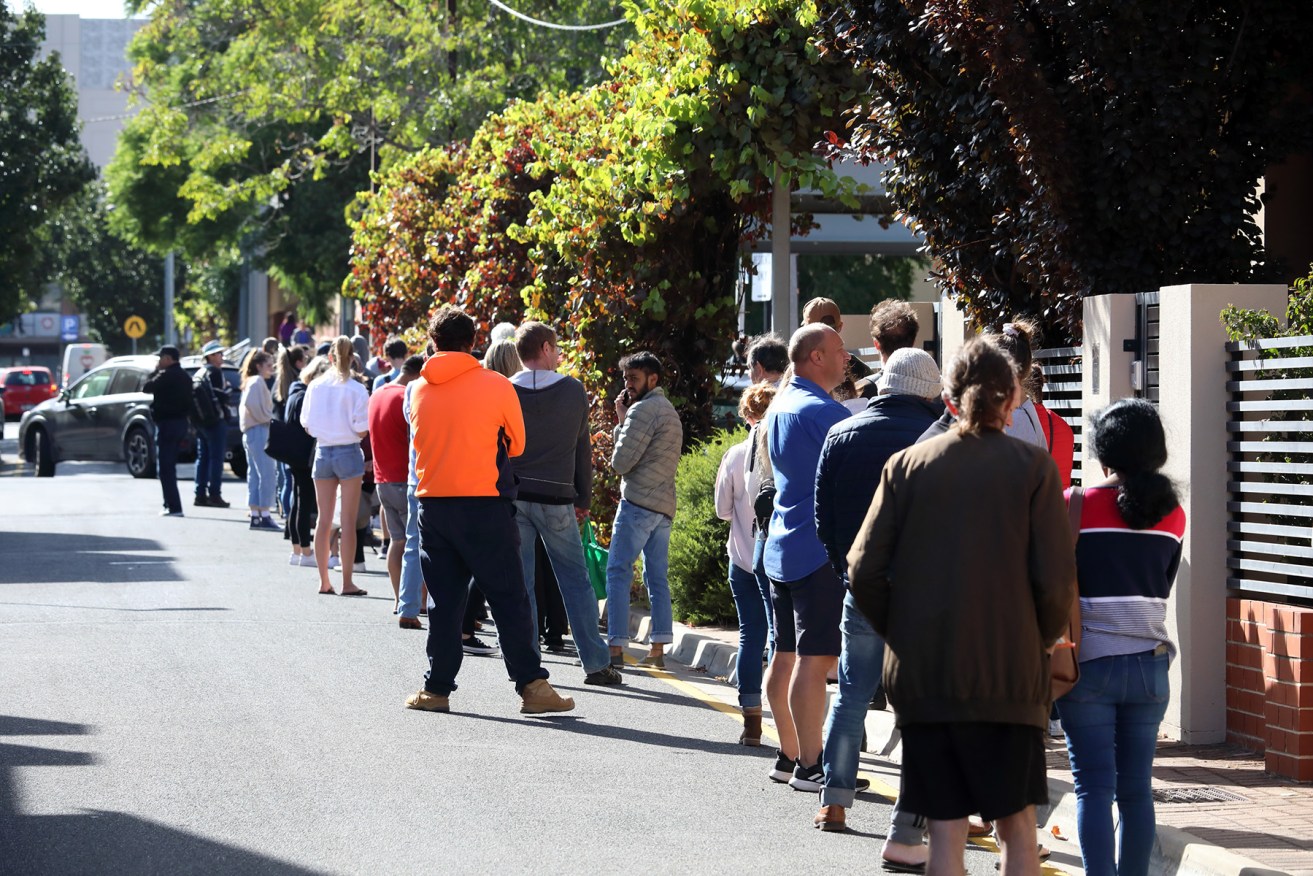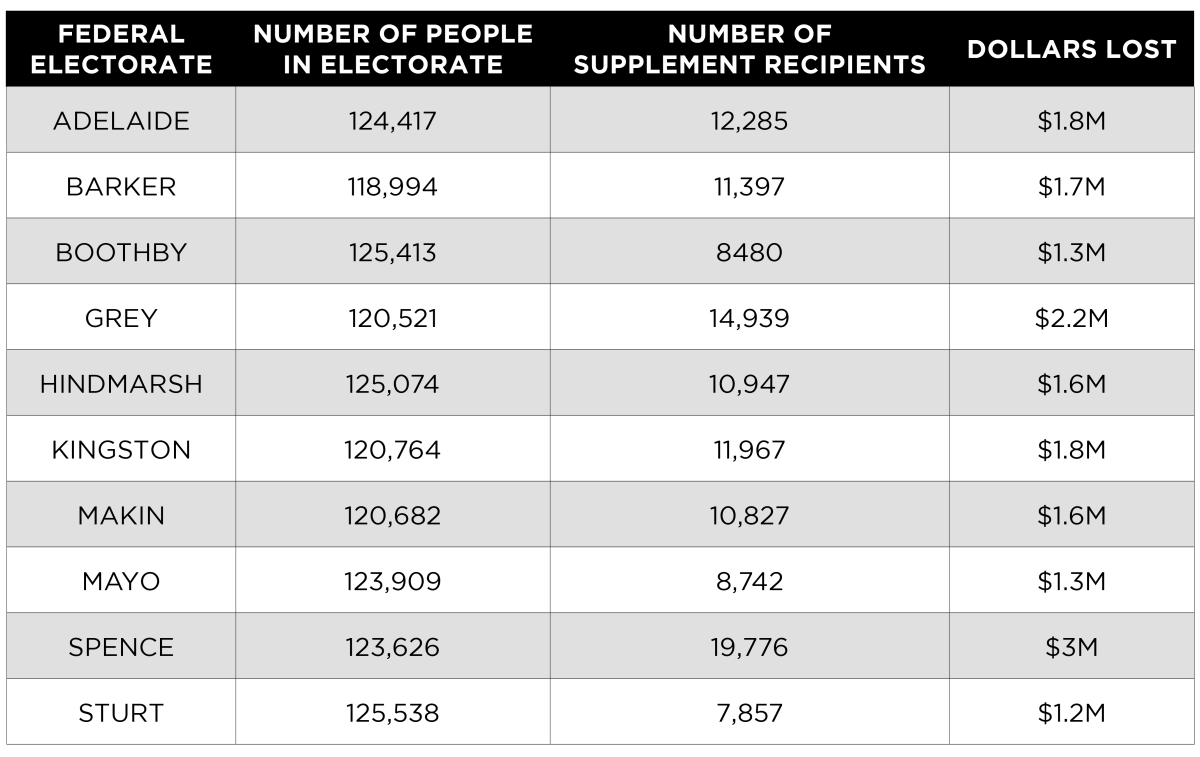SA economy to lose millions when JobSeeker supplement axed
About $35 million a month will be stripped from the South Australian economy when the JobSeeker coronavirus supplement is axed in March, according to analysis of data from federal electorates and the federal Parliamentary Library.


People queue around the corner from an Adelaide Centrelink office. Photo: Tony Lewis/InDaily
South Australia’s ten federal electorates stand to lose more than $17 million each fortnight after the $150 top-up payment for JobSeeker and Youth Allowance is abolished, as the Morrison Government winds back emergency financial stimulus measures introduced after widespread pandemic shutdowns wreaked havoc on jobs, businesses and the economy.
InDaily has examined the impact on South Australia’s bottom line through Parliamentary Library data and estimated $17.5 million would be lost across the state each fortnight.
The loss in local incomes may be an over or underestimate because some individuals may be on part payments, which has not been publicly disclosed.
The federal seats of Spence and Grey would lose about $3 million and $2.2 million a fortnight respectively, while Adelaide would be the third hardest hit electorate, losing more than $1.8 million.
A single South Australian JobSeeker with no children currently receives a fortnightly payment of $715.70, which includes the $150 coronavirus supplement.
From April 1, the payment is set to return to $565.70, with South Australians on Youth Allowance returning to $252.20 per fortnight.
Parliamentary Library figures showed in South Australia there were a total of 117,216 people on JobSeeker, Youth Allowance and related payments as of December.
Financial firm Deloitte last year found eliminating the coronavirus boost would have a far-reaching impact on the nation’s economy in the midst of the economic downturn, arguing in September that the reduced expenditure was equal to an average loss of 145,000 full-time jobs over two years.
Deloitte reported regional areas would be worst off as a result of the payment reduction and that “every dollar getting pumped back into the Australian economy is doing more good than ever before”.
Guardian Australia recently published analysis forecasting a national $300 million economic hit when the supplements are axed on March 31.
Labor MP for Spence Nick Champion said while the impact of cutting the supplement would be felt across Adelaide’s northern suburbs, the whole country would benefit from a permanent increase.
“It doesn’t matter if you’re in Elizabeth or Port Adelaide of the centre of Adelaide or Cairns, it’s a national system and should be set at a rate that keeps people out of poverty,” he said.

The federal electorate data in boxes one and two (above) are sourced from Australian Electoral Commission figures as of December 31, 2020. The number of people in each electorate receiving coronavirus supplement on top of JobSeeker and Youth Allowance payments (box three above) was sourced from the Federal Parliamentary Library. InDaily has taken the number of recipients receiving the coronavirus supplement in each electorate and multiplied it by $150 to calculate the money lost each fortnight when the allowance is removed on March 31 and rounded in to the nearest single decimal.
It follows a submission by the nation’s peak welfare group calling for JobSeeker and Youth Allowance to be raised in line with the Disability Support Pension rate of $944 per fortnight for a single person.
The calls have also been backed by reports arguing the wider, immediate benefit of spending by welfare recipients.
But the Federal Government has remained tight-lipped on its plans to boost the payment, with Prime Minister Scott Morrison last week saying, “more data” was required on the most recent labour force figures before the government could make a decision.
In response to questions about raising the welfare rate, the office of Social Services Minister and SA Senator Anne Ruston directed InDaily to comments by the Prime Minister last week, in which he said the matter was still being considered.
Ruston’s office did not respond to questions about the impact on South Australia’s economy.
Champion said he backed a boost to the low-income payments in line with the pension.
“In an ideal world, you’d have a single rate for people struck probably at the Disability Support Pension rate where people could live not an indulgent life but get by, stay out of poverty, have a reasonable level of dignity and participate in society,” he said.
“We’ve really got to focus on who’s actually on JobSeeker, it’s typically someone who’s worked all of their working life, up until they’ve been made redundant or been put off.
“To have to deal with this system that’s not fit-for-purpose doesn’t keep people out of poverty, doesn’t get people into work and then they often really desperately try to get a job, only to find themselves locked out of the labour market.
“The coronavirus supplements have given people dignity and lifted people across the country out of poverty and the government now seems determined to put them back into poverty.
“We really have to have a good public discussion about how we construct a social safety net that gives people dignity and a role in society, ideally in paid work but if not in paid work then some other meaningful way of making a contribution.”
Labor MP for Hindmarsh Mark Butler said the Prime Minister’s plan to cut economic support was “not a plan for jobs”.
“How many local businesses and how many local jobs will be affected when Scott Morrison cuts JobSeeker?” He asked.
“With two million Australians looking for work or in need of more hours, and the number of Australians on unemployment support almost doubling since before the recession, it is incomprehensible that the Government is planning to cut JobSeeker.”
SA Treasurer Rob Lucas echoed comments by Reserve Bank governor Philip Lowe last week that welfare payments should be increased.
But, like Lowe, Lucas said the “actual number” of the permanent welfare payment was for the Federal Government to decide.
“This is a matter for the Federal Government, we’re mindful of the fact that they’re running significant deficits at the moment but bearing that in mind … we’re sympathetic to the arguments that have been put for some ongoing increase in JobSeeker,” he said.
“In terms of economic stimulus, increases in expenditure or income for those who receive the supplement, a good deal of that ends up flowing through the economy because it helps to pay for necessary goods and services that those households have been spending their money on for how ever long it’s been, the last 12 months or so.
“From that view point it’s A, good for individual households but also B, as the Reserve Governor has indicated a benefit for the national economy and also for the state’s economy as well.”




